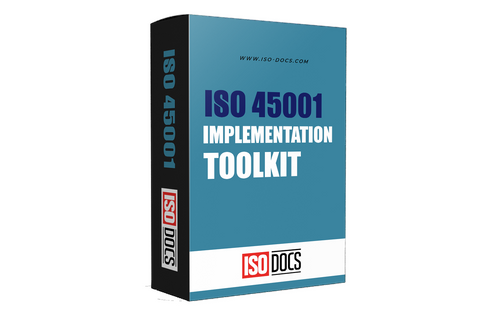ISO 45001 Implementation Toolkit Template
Introduction
The occupation health and safety (OHS) is not a mere check box on a regulation anymore but a pillar of responsible sustainable business. The internationally known OHS management system standard of ISO 45001 enables organizations to recognize hazards, manage risks, and establish a culture of relentless safety enhancement. However, the implementation of the ISO 45001 requirements and their turn into the daily workplace practice is a complicated task. The ISO 45001 Implementation Toolkit can solve this difficulty as it provides a curated collection of templates, resources, guides, and online tools to facilitate compliance, improve safety, and involve all levels of personnel.

ISO 45001 Implementation Toolkit Purpose
The essence of an ISO 45001 toolkit is to make the implementation of the standard straightforward and easy and translate complex provisions into concise steps. Toolkits are useful in bridging the gap between theory and practice by:
-
Interpreting standards into business instructions: The standards, explain the requirements and have a stepwise approach to each clause and control.
-
Bringing teams prepared templates: Templates of risk assessment, policy writing, incident reporting, and internal audits save time and align practices to ISO standards.
-
Organizing the project: From gap analysis to management review and certification audit, toolkits synchronize project schedules, duties, and milestones.
-
Making documentation simple: Toolkits include document control systems, versioning, and access tracking to reduce compliance risk and audit problems.
- Developing awareness and competence: By providing training materials, communication plans, and engagement guides, the toolkit encourages safety awareness at all levels.
Best Practices Of An ISO 45001 Implementation Toolkit
1. Leadership and Participation of the Worker
Ensure top management sponsorship. Leaders must familiarize themselves with the toolkit and work on setting policy, resource allocation, and advocating a safety-first culture. With survey templates and feedback trackers, engage employees by gathering their opinions, consultation, and safety ideas.
2. Strategic Planning and Evaluation of the Gaps
With the use of gap analysis tools, you are able to see the current position of the organization and what the goals and project plans should be. Allocate maximum resources to the highest risks and regulatory gaps.
3. Adapt Document and Processes
Alter the toolkit templates (policies, procedures, risk assessments, and training plans) to fit the specific organization’s environment, risks, and compliance needs. Ensure procedures are relevant to the site—avoid copy-paste.
4. Use of Technology
Implement an electronic document management system (EDMS) or cloud-based versions of the OHSMS for document control, workflow, and access. Use dashboards to track completion of actions, training status, and incident statistics.
5. Awareness and Training
Implement toolkit materials through hands-on projects as training. Use video instructions, e-learning units, and posters for wider staff engagement across departments.
6. Implement Assessment Criteria
Conduct periodic assessments using management review templates and internal audit checklists. Track closure of corrective actions and monitor improvements using toolkit tracking.
7. Change Management And Continuous Improvement
Document lessons learned, improvement actions, and change impacts using toolkit logs and change plans. Keep procedures current, train staff, and recognize safety achievements.
8. Integration With Other Standards
Integrate the ISO 45001 toolkit with other systems like ISO 9001 (quality) and ISO 14001 (environment), making safety part of your overall management framework.
-
- Audit and Management Reviews: schedules, agendas, reports, and action plans.
- Records and referencing: version logs, retention schedules, registers.
- Training-needs analysis and competency tools: competency matrix, training needs analysis, and modules.
- Audit and Management Reviews: schedules, agendas, reports, and action plans.

Benefits Of The Implementation Toolkit For ISO 45001
Better Health and Safety
Organizations that used an implementation toolkit report significantly reduced work-related accidents, near misses, and occupational diseases. The safety culture is strengthened, and employees feel valued, secure, and involved.
Automated Compliance and Audit Readiness
Toolkits structure compliance activities, simplify audits, facilitate nonconformance tracking, and reduce legal liability. Documentation is generated and maintained in an auditable way.
Enhanced Efficiency and Productivity
Standardized templates ensure efficiency, avoiding duplication and gaps. Fewer incidents mean fewer interruptions and downtime for business.
Reduced Costs
By curbing accidents and simplifying compliance, toolkits lower costs associated with crises, compensation, insurance premiums, and regulatory defense.
Continuous Improvement
Toolkits focus on performance review and continuous improvement, empowering organizations to develop innovation-driven, safer workplaces.
Reputation, Trust, and Stakeholder Value
Certification to ISO 45001 with implementation toolkits builds reputation, increases stakeholder confidence, and demonstrates sustainability and social responsibility.
Global Recognition
Being an international standard, implementing ISO 45001 with toolkits ensures access to international markets and supports global expansion.
Key Toolkit Components
- Gap analysis and project planning tools (diagnostic surveys, SMART goals).
- OHS policy templates and leadership briefing materials.
- Procedures for hazard identification, operational controls, and emergency plans.
- Legal register and compliance tracking dashboards.
- Document control templates (version logs, retention schedules).
- Competency and training need analysis tools.
- Stakeholder communication and worker engagement plans.
- Incident and nonconformance management: report and investigation forms, action trackers.
- Audit and management review checklists, agendas, and reporting templates.
- Change management templates and PDCA cycle resources for continuous improvement.
Conclusion
Having a proper ISO 45001 implementation toolkit is more than an option; rather it is a lifeline for promoting occupational health and safety, operational efficiency, and compliance. By providing structure, best practices, and strategic benefits, the toolkit reduces the daunting task of OHSMS implementation into a manageable process. It drives employee engagement, leadership empowerment, and continuous improvement.


